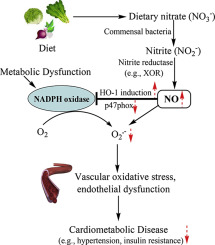当前位置:
X-MOL 学术
›
Nitric Oxide
›
论文详情
Our official English website, www.x-mol.net, welcomes your
feedback! (Note: you will need to create a separate account there.)
Supplementation of dietary nitrate attenuated oxidative stress and endothelial dysfunction in diabetic vasculature through inhibition of NADPH oxidase.
Nitric Oxide ( IF 3.2 ) Pub Date : 2020-01-21 , DOI: 10.1016/j.niox.2020.01.007 Rong Tian 1 , Rou Peng 1 , Ziyi Yang 1 , Yi-Yuan Peng 1 , Naihao Lu 1
Nitric Oxide ( IF 3.2 ) Pub Date : 2020-01-21 , DOI: 10.1016/j.niox.2020.01.007 Rong Tian 1 , Rou Peng 1 , Ziyi Yang 1 , Yi-Yuan Peng 1 , Naihao Lu 1
Affiliation

|
The metabolic disorders in diabetes, which are usually accompanied by oxidative stress and impaired nitric oxide (NO) bioavailability, increase the risk of detrimental cardiovascular complications. Herein, we investigated the therapeutic potential of dietary nitrate, which is found in high content in green leafy vegetables, on vascular oxidative stress and endothelial dysfunction in diabetic mice induced by high-fat diet and streptozotocin injection. Dietary nitrate in drinking water fuelled a nitrate-nitrite-NO pathway, which inhibited vascular oxidative stress, endothelial dysfunction and many features of metabolic syndrome in diabetic mice. These beneficial effects of nitrate on diabetic mice were abolished by PTIO (NO scavenger) treatment and significantly prevented by febuxostat (xanthine oxidoreductase inhibitor), demonstrating the central importance of NO in bioactivation of nitrate. The favorable effects of nitrate were not further influenced by apocynin (NADPH oxidase inhibitor), suggesting NADPH oxidase as a possible target. In high glucose-incubated vascular endothelial cells, NO donor attenuated oxidative stress and endothelial dysfunction via the inhibition of NADPH oxidase, where a heme oxygenase-1 (HO-1)-dependent mechanism was demonstrated for the antioxidant abilities of NO. Altogether, boosting this nitrate-nitrite-NO signaling pathway resulted in the decreases of NADPH oxidase-derived oxidative stress, endothelial dysfunction and metabolic disorders in diabetic vasculature. These findings may have novel implications for the preventive strategy against diabetes-induced vascular dysfunction and associated complications.
中文翻译:

饮食中硝酸盐的补充通过抑制NADPH氧化酶减轻了糖尿病脉管系统的氧化应激和内皮功能障碍。
糖尿病中的代谢紊乱通常伴有氧化应激和一氧化氮(NO)生物利用度降低,增加了有害的心血管并发症的风险。在这里,我们研究了饮食中硝酸盐的治疗潜力,该饮食在绿叶蔬菜中含量高,对高脂饮食和链脲佐菌素注射液诱导的糖尿病小鼠的血管氧化应激和内皮功能障碍具有治疗作用。饮用水中的膳食硝酸盐促进了硝酸盐-亚硝酸盐-NO的传递,从而抑制了糖尿病小鼠的血管氧化应激,内皮功能障碍和许多代谢综合征。硝酸盐对糖尿病小鼠的这些有益作用已通过PTIO(NO清除剂)治疗而被消除,而被非布索坦(黄嘌呤氧化还原酶抑制剂)所阻止,证明了NO在硝酸盐生物活化中的重要作用。Apocynin(NADPH氧化酶抑制剂)不会进一步影响硝酸盐的有利作用,表明NADPH氧化酶可能是目标。在高葡萄糖温育的血管内皮细胞中,NO供体通过抑制NADPH氧化酶来减轻氧化应激和内皮功能障碍,其中血红素加氧酶-1(HO-1)依赖性机制被证明具有NO的抗氧化能力。总而言之,增强这种硝酸盐-亚硝酸盐-NO信号传导途径导致了糖尿病性脉管系统中NADPH氧化酶衍生的氧化应激,内皮功能障碍和代谢紊乱的减少。这些发现可能对预防糖尿病引起的血管功能障碍和相关并发症的策略具有新的意义。
更新日期:2020-01-21
中文翻译:

饮食中硝酸盐的补充通过抑制NADPH氧化酶减轻了糖尿病脉管系统的氧化应激和内皮功能障碍。
糖尿病中的代谢紊乱通常伴有氧化应激和一氧化氮(NO)生物利用度降低,增加了有害的心血管并发症的风险。在这里,我们研究了饮食中硝酸盐的治疗潜力,该饮食在绿叶蔬菜中含量高,对高脂饮食和链脲佐菌素注射液诱导的糖尿病小鼠的血管氧化应激和内皮功能障碍具有治疗作用。饮用水中的膳食硝酸盐促进了硝酸盐-亚硝酸盐-NO的传递,从而抑制了糖尿病小鼠的血管氧化应激,内皮功能障碍和许多代谢综合征。硝酸盐对糖尿病小鼠的这些有益作用已通过PTIO(NO清除剂)治疗而被消除,而被非布索坦(黄嘌呤氧化还原酶抑制剂)所阻止,证明了NO在硝酸盐生物活化中的重要作用。Apocynin(NADPH氧化酶抑制剂)不会进一步影响硝酸盐的有利作用,表明NADPH氧化酶可能是目标。在高葡萄糖温育的血管内皮细胞中,NO供体通过抑制NADPH氧化酶来减轻氧化应激和内皮功能障碍,其中血红素加氧酶-1(HO-1)依赖性机制被证明具有NO的抗氧化能力。总而言之,增强这种硝酸盐-亚硝酸盐-NO信号传导途径导致了糖尿病性脉管系统中NADPH氧化酶衍生的氧化应激,内皮功能障碍和代谢紊乱的减少。这些发现可能对预防糖尿病引起的血管功能障碍和相关并发症的策略具有新的意义。











































 京公网安备 11010802027423号
京公网安备 11010802027423号